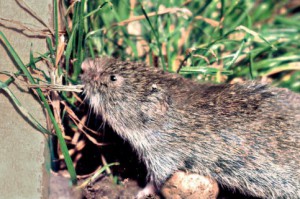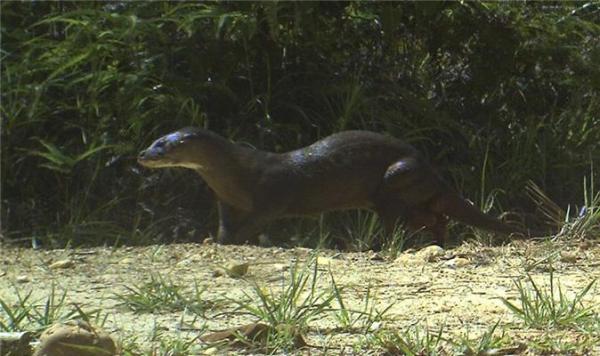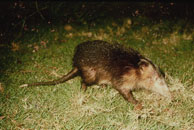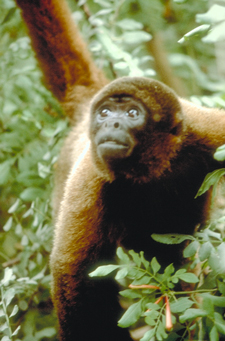Where To Look For Extinct Animals?
Posted by: Loren Coleman on March 16th, 2011
Biologist Diana O. Fisher, Division of Botany and Zoology, Australian National University, has written an important contribution to the literature on the methodology for the rediscovery of rare, endangered, and apparently extinct mammalian species. One of the keys to finding animals may not necessarily be to search where they were formally found, but, instead, to look at the “range edges and marginal habitat.” See the abstract to this new study, below.


One of the species that Fisher has previously written about is the above pictured mammal, Microtus bavaricus (Konig, 1962). This species had not been seen since 1962, until it was rediscovered in Austria in 2000. The mammal was rediscovered by Dr. Friederike Spitzenberger from the Naturhistorisches Museum, Wien, during a live-trapping session in the Rofan mountains, which are in the Brandenberg Alps, Austria. The rediscovery location was not specifically near their original type locality, which was the previously known one site where they were found, in Garmisch-Partenkirchen, Bavaria, Germany. The Bavarian pine vole (Microtus bavaricus) is a vole, now known from the Austrian, Italian, and Bavarian Alps of Europe.
Fisher, Peter Maas, and their colleagues have gathered an amazing database of rediscovered mammals. See here.

The rediscovered hairy-nosed otter (Lutra sumatrana) was photographed by an automated camera trap set up by the Conservation of Carnivores in Sabah project; it was announced in 2010. Photo ~ Mohamed & Wilting, SWD, SFD.
In 2008, scientists observed a living pygmy tarsier (Tarsius pumilus), one of the planet’s smallest and rarest primates, for the first time since 1921. The primate was rediscovered on a misty mountaintop, on the Indonesian island of Sulawesi.
Fisher, Diana O. (2011) “Trajectories from extinction: Where are missing mammals rediscovered?”
Global Ecology and Biogeography, In Press.
Aim:
To determine where mammals that are presumed to be extinct are most likely to be rediscovered, and to test predictions of two hypotheses to explain trajectories of decline in mammals. Range collapse is based on the premise that extinction rates at the edge of species ranges are highest because habitat is suboptimal, so declining species are predicted to survive longer near the centre of their ranges. We predicted that under range collapse, remnant populations are most likely be rediscovered within their former core range. Conversely, if threats usually spread across ranges, declining species will be pushed to the periphery (range eclipse), so rediscoveries are predicted at the edge of the pre-decline range. If so, species would be more likely to be rediscovered in marginal habitat, and at higher elevations than the sites from which they disappeared.
Methods:
Using data on 67 species of mammals which have been rediscovered, I tested whether species were disproportionately rediscovered in the outer 50% of their former range area or at higher elevations than their last recorded locations, and which species characteristics were associated with rediscovery location and habitat change, using both the phylogenetic generalized least squares method to account for phylogenetic non-independence and linear models of raw species data.
Results:
Species affected by habitat loss were more likely to be rediscovered at the periphery than the centre of their former range, consistent with range eclipse caused by the spread of habitat destruction. High human population pressure predicted which species changed habitat between their previous records and rediscovery. Coastal species experienced higher human population densities, and were more likely to be rediscovered at the periphery of their former ranges, and there was some evidence of an up-slope shift associated with higher human populations at lower elevations.
Main conclusion:
The locations of rediscoveries of species affected by habitat loss were consistent with range eclipse through a mechanism of spreading habitat loss and human population pressure, rather than with range collapse. Searches for mammals that have declined from habitat loss should include range edges and marginal habitat, especially in areas of high human population density.

The Cuban solenodon (Solenodon cubanus), a primitive insectivore, was believed to be extinct until its rediscovery in 2003.

The yellow-tailed woolly monkey (Lagothrix flavicauda), a distinct species of woolly monkey, was thought to be extinct until its rediscovery in 1974, in the Peruvian Andes.
About Loren Coleman
Loren Coleman is one of the world’s leading cryptozoologists, some say “the” leading living cryptozoologist. Certainly, he is acknowledged as the current living American researcher and writer who has most popularized cryptozoology in the late 20th and early 21st centuries.
Starting his fieldwork and investigations in 1960, after traveling and trekking extensively in pursuit of cryptozoological mysteries, Coleman began writing to share his experiences in 1969. An honorary member of Ivan T. Sanderson’s Society for the Investigation of the Unexplained in the 1970s, Coleman has been bestowed with similar honorary memberships of the North Idaho College Cryptozoology Club in 1983, and in subsequent years, that of the British Columbia Scientific Cryptozoology Club, CryptoSafari International, and other international organizations. He was also a Life Member and Benefactor of the International Society of Cryptozoology (now-defunct).
Loren Coleman’s daily blog, as a member of the Cryptomundo Team, served as an ongoing avenue of communication for the ever-growing body of cryptozoo news from 2005 through 2013. He returned as an infrequent contributor beginning Halloween week of 2015.
Coleman is the founder in 2003, and current director of the International Cryptozoology Museum in Portland, Maine.











Most species which have been rediscovered were poorly known in the first place, especially the true extent of the habitat. So of course rediscoveries of species (and subspecies) outside of their historically known range will be common.
I’m not a biologist so stop me if I’m wrong here.
But isn’t this kind of an obvious conclusion?
1) Center of range tends to get obliterated, because for many if not most species (maybe I should say “most if not all), the best range for them is the best range for us too.
2) Ergo, the “edge of the pre-decline range” tends to be where there are fewer of us.
3) We just tend not to look for animals in what we consider marginal habitat for them.
Where this might help the search for a certain cryptid:
We presume that certain cryptid (hint: Cryptomundo flagship critter) to only be found in really remote areas, by current standards. The best way to think of it is to look where our biggest cities are; that was really really good wildlife range, before we got through with it. So finding that certain cryptid across the continent – it’s mobile, and smart, and a catholic eater, so why not? – at the edges of what used to be fantastic habitat for it isn’t a stretch at all.
DWA wrote: “the best range for them is the best range for us too.”
The number of niches, environments, and ranges that are obviously NOT great, good, or even fair for humans compared to all other mammals is enormous.
Loren: Really, what you’re saying is that I should say “many if not most,” and not “most if not all.”
Maybe.
Humans have pushed many animals – including all the big terrestrial ones – into the least-hospitable places they can live. The grizzly and wolverine were everywhere in the West; elk wolf cougar and bison everywhere in the East as well. The bighorn sheep used to abound on the Great Plains; they sought out those inhospitable high crags because we killed them off wherever they were easy to get to. Most of the remaining “untouched” habitat for terrestrial mammals is in the places we have set aside for them – where we could set up shop easily if we wanted to.
Let’s give humans more credit. In the most inhospitable places we live, we’re considerably more comfortable, I’d say, than the wild animals with which we share that range. In the places where we simply don’t (obviously I’m not talking about places we have set aside like parks and refuges, but about “inhospitable” places like mountain peaks and deserts and polar wastes and underwater), species are few and big animals even fewer (whales, seals, penguins and the like being exceptions that prove the rule). If humans had settled, literally, everywhere we could live, there wouldn’t be much left bigger than fox-size. And only those animals who learned to scavenge off us and our livestock would be left, pretty much. Our parks and refuges are the only significant reservoirs of large-animal biodiversity we have left. We set them aside, largely, to avoid overrunning them ourselves.
Now if you’re talking mice, we can talk Austria. There’s a tiny trickle of larger stuff – some ibex, a very few bears, maybe a wolf here and there – hanging on in places we could live, but have left to them.
I still think that this finding isn’t a surprise, and is sort of stating the obvious.
With that cryptid tip that I’ll let stand as well. 😉
“it’s mobile, and smart, and a catholic eater”….
I’m safe, I’m an atheist…..
Larger animals tend to have lower population densities, so they are more at risk of extinction. And apex predators (bears, wolves, thylacines etc.) tend to have the lowest population densities of all. Functional extinction also comes a lot sooner too. Perhaps we have forced them into new niches in which they can just barely survive. But more likely, they survive only in those areas of their historical range that we do not inhabit as well, for one reason or another.
Bigfoot being pushed to higher elevations? e.g. the Cascades, Appalachians and even as I have recently studied out, the Bradshaw mountains in Arizona?
‘Mountain devils’ may used to have been called ‘forest devils’?
OK, so let’s expound. It’s Cryptomundo, right? Of course I’m talking sasquatch.
One frequently hears skeptical thinkers – and even some proponents – saying that it’s very unlikely to impossible that the sasquatch, if it’s real, lives outside of places that are very remote by current standards, i.e., the Pacific Northwest. (Alaska and Western Canada might not come up for discussion because, although remote, we just can’t as a culture mentally fit apes into cold places.) The thinking seems to be that an animal this elusive couldn’t possibly be in a place where it would have to be seen frequently (like say, the Texas counties bordering Houston, the fourth-largest city in the US, which report concentrations of sasquatch sightings).
In terms of the current topic, here is why I personally have problems with that thinking.
1. The PNW isn’t the most species-rich part of the continent, by a good bit. Now – thanks to our destructive ways – it might be up there. But historically (compared to MD and VA, say), no way. It simply doesn’t have the diversity of habitats required.
2. Apes, where we know they are found, are exclusively found in species-rich environments.
3. The sasquatch seems to run against that thinking, in that the places they are reputed to be are not nearly as rich as the tropical forests in which known apes are found.
4. But most kinds of mammals – cats; dogs; deer; cattle; bears; primates; etc. – have representatives not just in tropical, but in temperate and even arctic and subarctic environments. (There are monkeys living in places where winter temperatures routinely get as low as minus-30 F.) So the concept of apes – among the smartest mammals, with demonstrated omnivory – in the temperate zone isn’t really farfetched at all.
5. One might expect, though, that apes – largely owing to their intelligence, I would think – would concentrate in the best habitats in the places they are found. But it would also make sense that they could take advantage – largely owing to their intelligence – of less than optimal places, too.
6. Historically, those places are where our biggest cities have sprung up. It’s worth noting here that the PNW areas postulated as prime sasquatch habitat aren’t particularly near, say, Portland or Seattle, which historically had much better habitat.
7. By this theory, it would make sense to me that the sasquatch – an animal that the evidence links very closely to water, and major bodies of water are practically a prime requisite of big cities – has been pushed away from prime habitat, which historically was where major-city centers now are, to its fringes, which …well, look at the BFRO and TBRC websites for what I’m talking about.
8. Oh. Evidence indicates that the sasquatch is seen much more frequently then either skeptics or many proponents (“they shape-shift; that’s why no one sees them, oh and they bury their dead too”) would have you believe.
In other words, according to this theory, that we are getting reports of a big, omnivorous, highly intelligent animal across a continent that has historically had high species diversity in many places – and that those places seem to have concentrations of sightings to this day – shouldn’t surprise us much.
Not a three-term syllogism, I know. But logically I like it.
ERRATUM:
“5. One might expect, though, that apes – largely owing to their intelligence, I would think – would concentrate in the best habitats in the places they are found. But it would also make sense that they could take advantage – largely owing to their intelligence – of less than optimal places, too.
6. Historically, those places are where our biggest cities have sprung up. …”
I added verbiage to 5. that clouds the meaning. The BEST habitats – not the less than optimal ones – are where our biggest cities are. The less than optimal places are where concentrations of sightings are: not as good, maybe, as the city sites once were, but still more than good enough to support a full range of species.